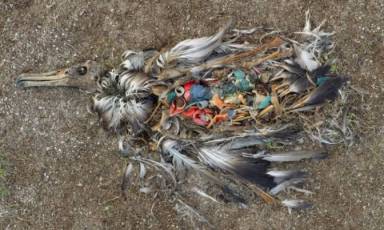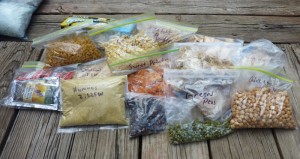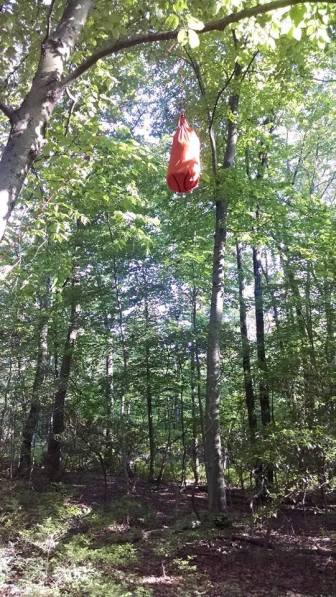**Warning: Some of the images below may be disturbing, however, it important to show others how our seemingly benign actions can drastically harm those with whom we share our planet. Take it from the words of “Hummingbird”, a young hiker who internalizes the Leave No Trace lessons on her hikes. Watch her brief video explanation here.
Why do we take hikes through the forest rather than walking through civilization? Could part of it be the rustic beauty of nature? The absence of trash and pollution? The crisp, fresh mountain air? Establish what you love most about your experience in the woods, and use that passion to make the trail a better place. Yes, carrying out your trash adds a good amount of weight to carry on a long distance hike. Maybe you’re tempted to lighten your load a bit. You may think it’s only one piece of trash, one chewed up piece of gum, who’s going to notice? Who’s going to care? This little guy might. 😦
 *Photo from http://www.overgrowthesystem.com
*Photo from http://www.overgrowthesystem.com
Character is how a person behaves when no one is watching. Practice Leave No Trace so that we can all enjoy the trail for what it is…an adventure in nature. Pure and simple. What is Leave No Trace? What are the “rules” for preserving our wilderness so that future generations can love it too? They can be summed up by remembering to leave nothing but footprints behind. The Appalachian Trail Conservancy has developed a few easy-to-follow guidelines to “Leave No Trace”:
- Plan ahead and prepare – When preparing for your big adventure, consider repackaging your food into Ziploc bags so that your trash load is more manageable. Plan to travel in small groups. Large groups wreak havoc on our beloved trail! Bring a waterproof stuff sack and a 50ft length of cord so you can safely keep your food away from wildlife.

- Travel and camp on durable surfaces – Use a trail guide which details camping guidelines so that you can take advantage of campsites that already exist. AWOL’s A.T. Guide 2016 is the most frequently used book by thru-hikers. The mobile app, Guthooks, is quickly gaining in popularity. I can’t sing its praises enough! Using your phone’s GPS, it works even with your phone on airplane mode, uses very little battery power, and shows you exactly where you are on trail and how far you are from water sources, shelters, etc. Warning: It can bit a bit addictive.
- Dispose of waste properly – Only carry in what you are willing to carry back out. It’s so disheartening to see liquor bottles, soda cans, and plastic wrappers littering our beautiful backcountry. Not only is it ugly, but you’d be surprised just how often innocent animals are injured or killed as a result of litter that was “too small to matter”.
Check out this quick video: Hummingbird trapped by a piece of chewed gum
Did you know leftover food should also be taken with you? It attracts pests, large and small, and who wants more of those around our campsites?
This Leave No Trace principle is also where the all-time favorite hiker initiation comes into play, that first poop in the woods. Privies are a luxury, but there will come a time when Mother Nature calls and no privy is nearby. Find a spot at least 200 feet away from water sources and the trail. Dig a hole at least 6 inches deep. I always used a tent stake for the digging until I learned just how handy a lightweight trowel is for when you’ve really got to go fast! Trowels are trophies that should be part of every hiker’s packing system. When finished with business, cover the hole and camouflage it with leaves or sticks. Your duty is done! Follow these guidelines and good trail karma will keep you from accidentally stumbling upon someone else’s waste. Trust me, that experience stinks.

- Leave the trail as you find it – Avoid building new fire rings or structures. Preserve the natural beauty, the reason we are all out there in the first place.
- Minimize campfire impacts – PLEASE don’t attempt to burn aluminum cans or packaging in fires. The experiment has been attempted over and over again only to prove those items do not burn down to ash. They leave our beloved campsites and trail ugly and pose a threat to surrounding wildlife.

- Respect wildlife – You will encounter hikers who refuse to hang their food. The problem with this, besides the increased risk of inviting large, threatening visitors to your sleeping area, is that as bears and other wildlife begin to associate humans and shelters with food they become fearless. Besides the danger this creates for hikers, bears become more aggressive and those who hang out around campsites and shelters often end up dead…our careless fault for not following simple guidelines. Most shelters on the A.T. have bear cables installed. See this link for how to hang your food from a tree branch: How to Hang a Bear Bag in the Woods (When I get back on trail in February, I will create a video demonstrating my own method for hanging a bear bag. For now, this one is very similar to how I do it.) Have fun with it and laugh at yourself the first few times. You’ll get better with practice. 🙂

- Be kind and considerate – The BEST experiences you’ll encounter during a thru-hike involve the incredible people you will meet both on trail and off. It pays to be polite and considerate of others. You might be one of the few who are able to complete a thru-hike totally on your own with no assistance from trail angels or friends, but I guarantee you it’s much easier and more pleasant if you create a respectful camaraderie with those who are part of the trail community with you. Kindness breeds peace. Peace is the trail’s best gift. Be a part of it.
Leave No Trace so that we can all enjoy the trail for what it is. Natural. Peaceful. Home.



4 thoughts on “What Harm Will One Piece of Litter Do?”